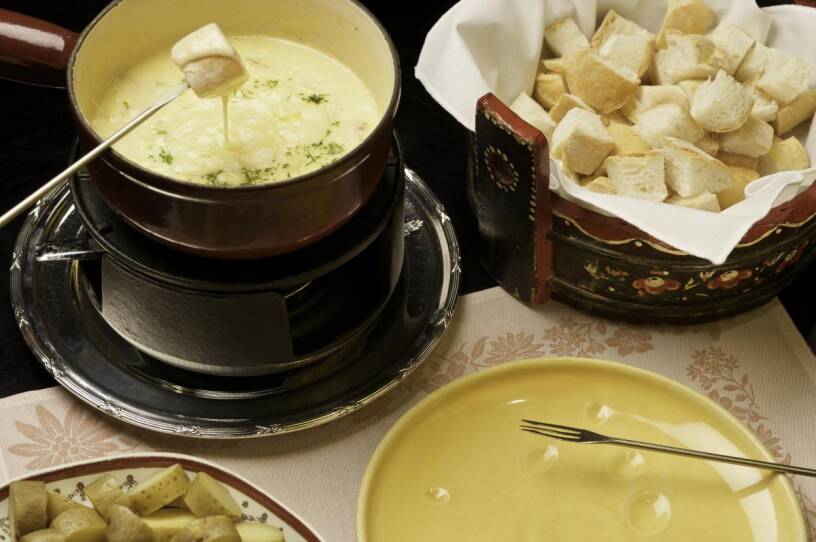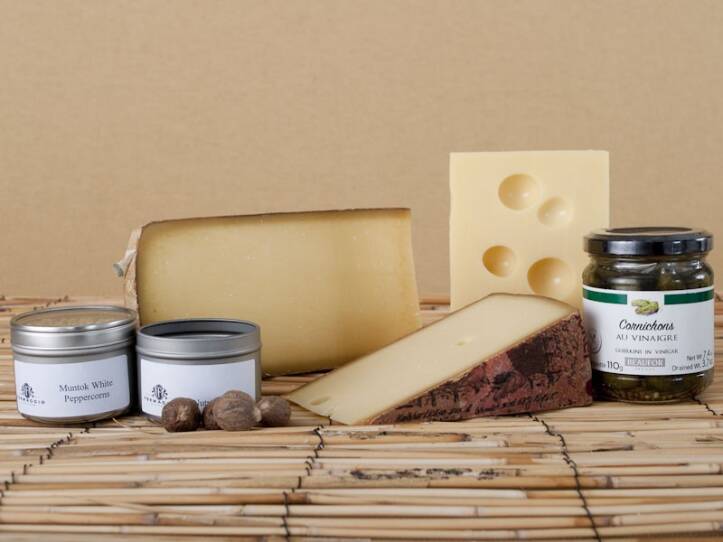I have a confession to make. I have eight fondue sets in my home. Yes, eight.
Because fondue is awesome.
Not only is dipping food into a pot of molten cheese and wine a really old way of eating (fondue as we know it today can be traced back to the 17th century), it’s also one of the most social and convivial culinary traditions there is. When the weather cools down my fondue sets come out, the wines get chilled, and the fêtes de fondue commence.
Named for the French verb fondré, “to melt”, fondue has always been strongly associated with the Swiss although amazing versions of melted cheese can be found all over the place.
In the Italian-speaking canton of Ticino, fonduta is made from cheese, egg, and milk. This creamy concoction is typically spooned over polenta. Head to the Netherlands, and you’ll enjoy kaaspott, “cheese pot”, prepared with Dutch cheeses. When it comes to fondue there are nearly as many recipes as there are mountain villages.
On my recent trip to Fribourg, Switzerland I was fortunate enough to spend some time with people who really know cheese, particularly the famous cheese of the region, Gruyère AOP. (The “AOP” stands for Appellation d’Origine Protegée, a regional guarantee of quality and origin.) Beyond spending time with extraordinary dairy farmers and cheesemakers, I was treated to some truly outstanding cheeses. Fondue was an inevitability, and happily so. I always welcome a chance to learn from the best.
Making fondue is about as easy as it can get. Using an earthenware vessel called a caquelon , garlic is rubbed all over the interior. White wine is heated and mixed with a little cornstarch to prevent clumping, then grated cheese is added and stirred until melted and smooth. That’s it.
Feeling fancy? Add a splash of kirsch (cherry brandy) and a grating or two of nutmeg and white pepper. Now the fun can begin.
Diners use small, elongated forks to dip just about anything. While bread and boiled potatoes are the most common foods served, the sky’s the limit. Mushrooms, apple slices, roasted veggies...if it can hold up to being submerged in hot cheese it’s good to go. As for sipping, chilled white wine is most commonly served. The Swiss also pair cider and hot, black tea. (It sounds odd, but tea and fondue is spectacular.)
While there are many different recipes, I usually find myself coming back to these three regional specialties. In no way am I suggesting these are the only recipes. I just think these are traditional, rock-solid crowd pleasers that even a nascent fondue enthusiast can ace.

Moitié-Moitié
French for “half-half”, this fondue name refers to the 50/50 blend of Gruyère AOP and Vacherin Fribourgeois AOP cheeses. This is the most popular recipe from the Fribourg region, and with good reason. The simplicity of cheese, garlic, white wine, and kirsch (cherry brandy) is goopy heaven in a bowl. A pinch of cayenne pepper adds a delightful layer of complexity. Moitié-Moitié is traditionally served with bread cubes and boiled potatoes.
Use this recipe straight from the Gruyère folks themselves. It will treat you right.
Fondue Neuchâteloise Gruyère AOP
Named for the canton of Neuchâtel, this fondue calls for Gruyère AOP cheese blended with savory and mild Emmentaler (this is the giant cheese with those holes everyone associates with “Swiss cheese”.) Lemon juice and white wine keep this fondue lively and flavorful.
As with most fondues, bread and potatoes are the most popular dipping items, but mushrooms, roasted broccoli florets and sausage slices are pretty excellent as well.
Luzerne Fondue
This visually stunning fondue comes from the German-influenced canton of Lucerne in Northern Switzerland. Made with a combination of Gruyère AOP and the more assertive Appenzeller cheese, the final step in making this beauty is to stir in a handful of freshly-chopped herbs. (The recipe here calls for chives and parsley, but I can personally vouch for tarragon as well.) The pot turns a beautiful hue of green and smells amazing.
I often like using New England cheeses for my fondues, and there are many great options. Springbrook Farm in Vermont , Landaff Creamery in New Hampshire , and Appleton Farms right here in Massachusetts are excellent options. Fortunately most hard cheeses work for fondue, and that includes just about all the alpine styles.
If you’re strapped for time or want to keep it über-simple, many cheese shops offer pre-mixed fondue kits to make it just that much easier. I’ve always had great luck with Formaggio Kitchen’s bundle , which includes whole nutmeg and white pepper. They even throw in a jar of cornichons - addictive little pickles I usually wind up snacking on while melting the cheese. Chill up a few bottles of white wine and you’re good to go.

A quick word on traditions - when it comes to fondue, there are several that should be observed. For example should a fella drop his morsel into the pot, he’s expected to buy a round for the table. Ladies bestow a kiss to each neighbor for the same crime. Another example calls for observation of the midi-boire (“half-way drink”), a shot of cherry brandy halfway through the meal for stamina.
My favorite is the fate of la religieuse (French for “the nun”), the crust formed on the bottom of the pot once the cheese is eaten. Under no circumstances is that to be discarded. With a little effort and gentle prodding it can be lifted and eated. If your party has a guest of honor, they are offered this morsel as gratitude for attending. If no such guest exists, keep the heat on the pot and crack an egg or two right on the nun. After a moment, start scrambling. Cheesy eggs, anyone?




